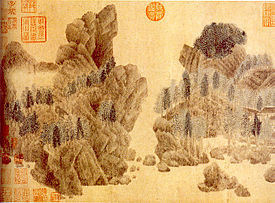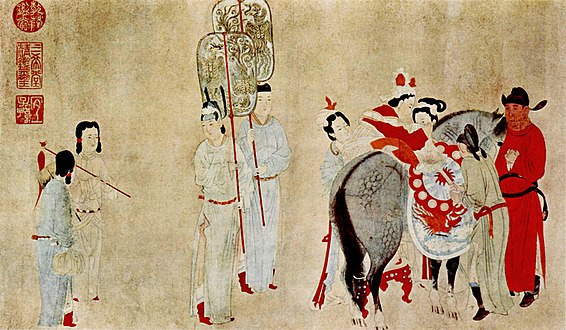Qian Xuan
Qián Xuǎn | |
|---|---|
 Dwelling in the Floating Jade Mountains (浮玉山居) | |
| Born | 1235 |
| Died | 1305 |
| Occupation | Painter |
Qian Xuan (simplified Chinese: 钱选; traditional Chinese: 錢選; pinyin: Qián Xuǎn; Wade–Giles: Ch'ien Hsüan; 1235-1305) courtesy name Shun Ju (舜举), pseudonyms Yu Tan (玉潭, "Jade Pool"), Xi Lan Weng (习嬾翁), and Zha Chuan Weng (霅川翁) ) was a Chinese painter from Hu Zhou (湖州) (the present day Wuxing District in Zhejiang)[1] during the late Song dynasty and early Yuan dynasty.
Biography[]
Qian Xuan started as an aspiring scholar-official during the rule of the Southern Song (960–1279). However, he had difficulty climbing the ranks of officialdom. When the Mongol-founded Yuan Dynasty took over the southern regions of China in 1276, he effectively gave up on the idea of a civil administration career. In 1286 his friend Zhao Mengfu found and accepted a position, and so for a time it seemed he could as well. However, he refused on patriotic grounds, while he citing old age in order to avoid difficulties. He nevertheless was considered a Song loyalist.
Qian Xuan's life after 1276 was devoted to painting, and he became noted as a "fur and feathers" painter. He was also adept at bird-and-flower painting, character painting, and landscape painting (shan shui).[1] He is known for landscapes that hinted at a longing for a return of native Chinese rule, such as in the work Home Again. He mixed Song realism with an archaic Tang style.
Works[]

Wang Xizhi, by Qian Xuan (1235-1305 AD)

Yang Guifei Mounting a Horse, by Qian Xuan (1235-1305 AD)

Early Autumn
Notes[]
- ^ Jump up to: a b Ci hai Page 1704
References[]
- Masterpieces of Chinese Art (page 87), by Rhonda and Jeffrey Cooper, Todtri Productions, 1997. ISBN 1-57717-060-1
- Ci hai bian ji wei yuan hui (辞海编辑委员会). Ci hai (辞海). Shanghai: Shanghai ci shu chu ban she (上海辞书出版社), 1979.
External links[]
![]() Media related to Qian Xuan at Wikimedia Commons
Media related to Qian Xuan at Wikimedia Commons
- Qian Xuan and his Painting Gallery at China Online Museum
- Museum of Fine Arts in Boston with three of his paintings
- Early Autumn
- Sung and Yuan paintings, an exhibition catalog from The Metropolitan Museum of Art Libraries (fully available online as PDF), which contains material on Qian Xuan (see list of paintings)
- 1235 births
- 1305 deaths
- 13th-century Chinese painters
- 14th-century Chinese painters
- Painters from Zhejiang
- People from Huzhou
- Song dynasty painters
- Yuan dynasty painters


